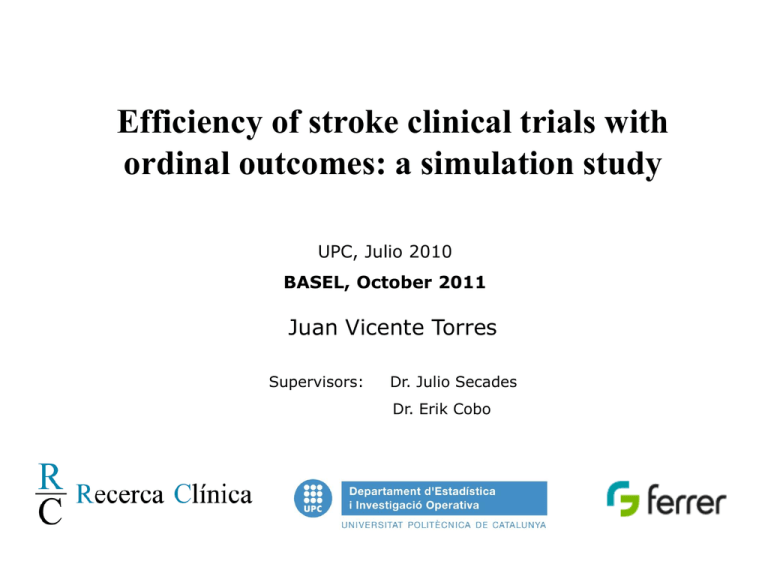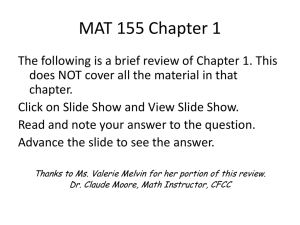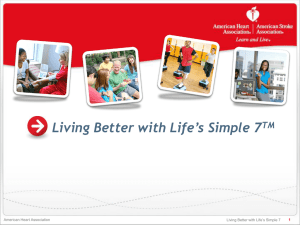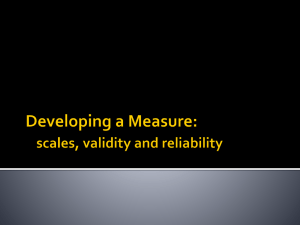
Efficiency of stroke clinical trials with
ordinal outcomes: a simulation study
UPC, Julio 2010
BASEL, October 2011
Juan Vicente Torres
Supervisors:
Dr. Julio Secades
Dr. Erik Cobo
Efficiency of stroke clinical trials with ordinal outcomes: a simulation study
Content
• Introduction
• Methods
– Patients
– Treatment effect imputation
– Assessed methods
• Results
• Conclusions
jvtorres@dm-stat.com
2/24
Efficiency of stroke clinical trials with ordinal outcomes: a simulation study
INTRODUCTION
jvtorres@dm-stat.com
3/24
Efficiency of stroke clinical trials with ordinal outcomes: a simulation study
• Stroke is the second most common cause of death and
a major cause of disability worldwide.
• Although at least 178 randomized clinical trials were
conducted for 75 promising agents, only 1 agent has
been approved by the FDA/EMA (2001).
jvtorres@dm-stat.com
4/24
Efficiency of stroke clinical trials with ordinal outcomes: a simulation study
The gold standard for performing Phase III clinical
trials has been to dichotomize the mRS as a good
outcome (scores 0 or 1):
0 - No symptoms.
1 - No significant disability. Able to carry out all usual activities
2 - Slight disability. Able to look after own affairs without assistance
3 - Moderate disability. Requires some help
4 - Moderately severe disability. Needs assistance
5 - Severe disability. Requires constant care and attention
6 - Dead.
jvtorres@dm-stat.com
5/24
Efficiency of stroke clinical trials with ordinal outcomes: a simulation study
Different alternatives have been proposed:
1. Shift Analysis [Savitz et al, 2007]:
–
Works with the full ordinal scale
2. Responder analysis [Berge et al, 2002]:
–
Dichotomizes the outcome taking into account the initial
status of each patient.
3. Global recovery outcome [Dávalos, 2002]:
–
Considers simultaneously information from more than one
recovery dichotomized variables.
jvtorres@dm-stat.com
6/24
Efficiency of stroke clinical trials with ordinal outcomes: a simulation study
Objective:
To assess the power of the most common statistical
methods used in stroke clinical trials and other
alternatives.
jvtorres@dm-stat.com
7/24
Efficiency of stroke clinical trials with ordinal outcomes: a simulation study
METHODS
jvtorres@dm-stat.com
8/24
Efficiency of stroke clinical trials with ordinal outcomes: a simulation study
Scales
• The modified Ranking Scale (mRS):
– Measures disability or dependence in daily activities.
– from 0 (perfect health) to 6 (death).
• The National Institute of Health Stroke Scale (NIHSS)
– Measures neurological status.
– from 0 (minimal) to 42 (severe deficit).
• The Barthel Index (BI)
– Measures independence in personal care and mobility.
– from 0 to 100 (independence) by steps of 5.
– It was transformed as iBI = (100-BI)/5.
jvtorres@dm-stat.com
9/24
Efficiency of stroke clinical trials with ordinal outcomes: a simulation study
Data
• Pooling database grouping 4 clinical trials performed to
assess the efficacy of oral citicoline.
• Applying new eligibility criteria, 1372 patients were
selected, 789 randomized to citicoline and 583 to
placebo.
• Only placebo data was employed in the simulations.
jvtorres@dm-stat.com
10/24
Efficiency of stroke clinical trials with ordinal outcomes: a simulation study
Addition of the treatment effect
• Using two different strategies:
– Partial (or patient) level: OAST collaboration, 2008
– Marginal (or population) level: Choi et al, 1998
• OR=1.20, 1.25, 1.30 and 1.35
• ORs under an ordinal logistic regression
jvtorres@dm-stat.com
(proportional odds)
11/24
Efficiency of stroke clinical trials with ordinal outcomes: a simulation study
Partial level
(1)
Split the data
randomly
Placebo
group
ORr ~ 1.0
(2)
Add the
Effect
Final placebo
group
ORg ~ 1.20, 1.25,...
Placebo patients
from the DB
Treatment
group
P(Y j )
Treatment
group
with effect
1
1 exp( j β' X)
P(Y j )
jvtorres@dm-stat.com
1
1 exp( j β' X log(OR))
12/24
Efficiency of stroke clinical trials with ordinal outcomes: a simulation study
Marginal level
(1)
Split the data
randomly
Placebo
group
ORr ~ 1.0
Placebo patients
from the DB
(2)
Add the
Effect
Treatment
group
Treatment
group
with effect
ORg =1.20, 1.25,…
Based on an ordinal logistic regression model,
a treatment effect is added redistributing the
patients within the scores
jvtorres@dm-stat.com
13/24
Efficiency of stroke clinical trials with ordinal outcomes: a simulation study
Example:
tx / mRS
0
1
2
3
4
5
6
Observed
16
30
45
47
72
20
55
-7 +12
-6 +18
-1 +19
36.6
50.9
48.7
Target
jvtorres@dm-stat.com
20.5
+5 +14
66.9
+3 +11
17.1
+11
44.3
14/24
Efficiency of stroke clinical trials with ordinal outcomes: a simulation study
Statistical methods to assess treatment effect
• Dichotomized mRS: mRS≤1 and mRS≤2.
• Full ordinal scale: t-test, Wilcoxon-Mann-Whitney test, ordinal
logistic regression with proportional odds.
• Responder analysis as proposed by Adams et al. (2004) and
Murray et al. (2005)
• A global ad-hoc version of the above methods is employed.
• The effect of adjusting for important prognostic variables in
each method is also assessed.
jvtorres@dm-stat.com
15/24
Efficiency of stroke clinical trials with ordinal outcomes: a simulation study
Power and alpha estimation
• The power was obtained as the percentage of significant
results over 10,000 iterations.
jvtorres@dm-stat.com
16/24
Efficiency of stroke clinical trials with ordinal outcomes: a simulation study
RESULTS
jvtorres@dm-stat.com
17/24
Efficiency of stroke clinical trials with ordinal outcomes: a simulation study
mRS after adding the treatment effect
Partial level
Marginal level
mRS before the treatment effect addition
3 4 5 6
0
1 2 3
0
1
2
OR =
1.20
0
1
2
3
4
5
6
16.0
17.6
17.3
18.1
18.8
4.1
8.2
12.2
15.5
16.6
18.7
21.5
5.0
10.5
14.5
17.9
18.1
18.6
18.7
4.0
8.1
9.8
13.8
16.0
19.1
23.5
5.5
12.4
5.3
8.9
12.3
18.1
28.1
8.0
19.5
4.1
6.8
9.6
14.8
27.2
9.4
28.1
3.1
5.5
8.7
15.2
30.1
9.9
27.6
100.0 7.7 1.1 0.2 0.0
0.0 92.3 12.4 2.0 0.3
0.0 0.0 86.5 13.7 1.8
0.0 0.0 0.0 84.2 10.8
0.0 0.0 0.0 0.0 87.2
0.0 0.0 0.0 0.0 0.0
0.0 0.0 0.0 0.0 0.0
0.0 0.0
0.1 0.0
0.5 0.1
3.2 0.4
25.2 2.9
71.0 7.9
0.0 88.8
OR =
1.35
0
1
2
3
4
5
6
17.3
18.3
17.7
17.7
17.9
3.7
7.3
13.4
16.3
16.9
18.5
20.7
4.6
9.5
16.0
18.7
18.3
18.2
17.6
3.7
7.4
10.8
14.7
16.4
19.1
22.5
5.2
11.3
5.9
9.5
13.0
18.5
27.7
7.6
17.9
4.6
7.4
10.2
15.0
27.6
9.1
26.0
3.4
6.0
9.4
16.0
30.1
9.6
25.4
100.0 12.0 2.5 0.6 0.1
0.0 88.0 17.8 4.4 0.9
0.0 0.0 79.7 19.2 4.0
0.0 0.0 0.0 75.8 15.5
0.0 0.0 0.0 0.0 79.5
0.0 0.0 0.0 0.0 0.0
0.0 0.0 0.0 0.0 0.0
0.1 0.0
0.4 0.1
1.6 0.3
6.5 1.2
32.8 6.0
58.7 10.5
0.0 81.9
jvtorres@dm-stat.com
4
5
6
18/24
Efficiency of stroke clinical trials with ordinal outcomes: a simulation study
Correlations between the original and simulated outcomes
Partial level
Marginal level
CHOI
0.96
Correlation
0.30
0.10
0.93
0.15
0.94
0.20
0.95
0.25
Correlation
0.35
0.97
0.40
0.45
0.98
OAST
1.20
1.25
1.30
OR
jvtorres@dm-stat.com
1.35
1.20
1.25
1.30
1.35
OR
19/24
Efficiency of stroke clinical trials with ordinal outcomes: a simulation study
Power comparison
jvtorres@dm-stat.com
20/24
Efficiency of stroke clinical trials with ordinal outcomes: a simulation study
Power comparison
jvtorres@dm-stat.com
21/24
Marginal level scenario
Efficiency of stroke clinical trials with ordinal outcomes: a simulation study
CONCLUSIONS
&
LIMITATIONS
jvtorres@dm-stat.com
22/24
Efficiency of stroke clinical trials with ordinal outcomes: a simulation study
Conclusions
• In Stroke trials, the analysis of ordinal scales might be
improved by
– taking into account the ordinal characteristic of the
scales,
– adjusting by prognostic variables,
– incorporating information of other scales.
• Need to define a formal method to incorporate these
three factors
jvtorres@dm-stat.com
23/24
Efficiency of stroke clinical trials with ordinal outcomes: a simulation study
Thanks!!
jvtorres@dm-stat.com
24/24








